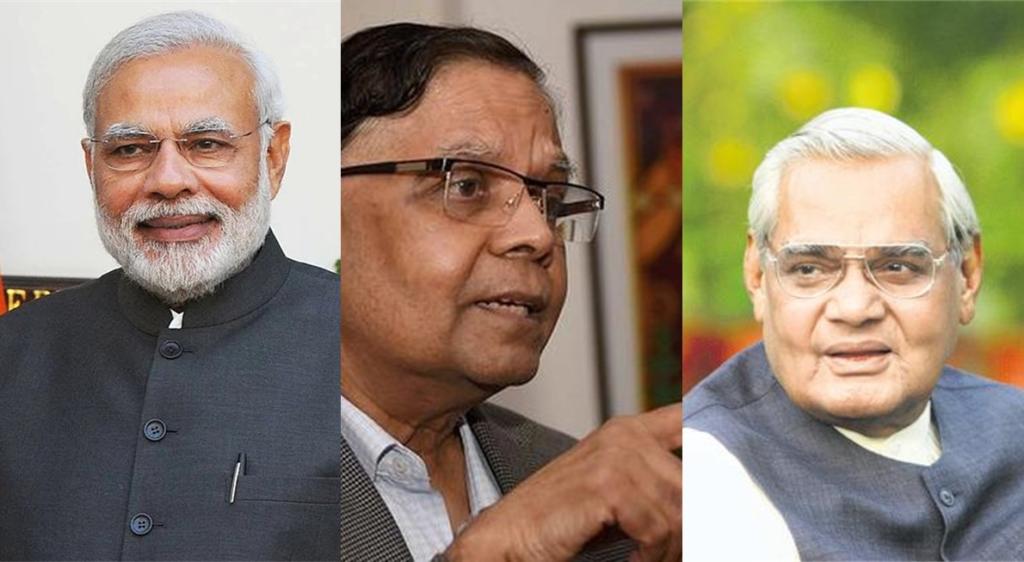Arvind Panagariya, former vice-chairman of the government of India think-tank NITI Aayog has praised the Modi government for economic reforms and credited Vajpayee era policies for the healthy economic growth during the first term of the UPA era. He also criticized the socialist economic policies such as ‘licence permit raj, distribution and price controls, and autarkic trade policy’ adopted in the post-independence era and blamed them for what was termed as the ‘Hindu rate of growth’ by some stupid economist. He credited the economic liberalization for the tremendous growth of the country in the last three decades and wrote, “The process of change began gathering steam only with liberalising reforms, first introduced grudgingly in the second half of the 1980s and then deliberately from 1991 onward.”
Pangariya took the critics of Modi government hands-on for the skewed approach as said “as a critic, if you choose to evaluate any of India’s governments according to problems that remain unsolved, you can have a field day. That is precisely the approach critics of Prime Minister Narendra Modi have taken.” Taking a bold stance on another term for theModi government, Panagariya argued that there is no healthy alternative available as any other formation would be some variation of the UPA government which proved disastrous for the economy of the country. “If this correct metric is applied, it is difficult to escape the conclusion that the present government has done splendidly well and that a return to any available alternative, which will inevitably be some variation of the erstwhile United Progressive Alliance (UPA), would set back India’s economic progress,” wrote Panagariya in the article in Economic Times.
On the high growth rates during UPA era, Panagariya wrote, “As I have maintained all along, the high growth rates during UPA rule largely represented a lagged response to the reforms that Prime Ministers Narasimha Rao and Atal Bihari Vajpayee had painstakingly implemented.”
One thing which is painful in the history of the economic growth of any country is that the leader whose administration takes the reforms recourse never gets credit for it in popular perception. This is not limited to India, it is a global phenomenon. In the United States, economic growth was excellent under the presidency of Bill Clinton and he was appreciated in the media for that. But the majority of economists agree to the assessment that high growth during the Clinton presidency was due to economic reforms initiated by Reagan administration.
The story has been repeated in India too, the Congress party claims that the first term of UPA was the golden era of Indian economic growth. But it is not ready to accept that the growth was a result of Vajpayee government’s policies. When the first Vajpayee government came to power, the macroeconomic fundamentals of the country were in shambles. The fiscal deficit was at 5.8 percent, CPI inflation was at 6.8 percent, Current Account Deficit (CAD) was at 1.3 percent and foreign exchange reserves were just 29.4 billion in the fiscal year 1997-98. So the country was weak on every major macroeconomic indicator. Now let us take a look at the same indicators in the fiscal year 2003-04 to examine whether the six years of Vajpayee led NDA rule improved the economy or not. In the fiscal year 2003-04, the fiscal deficit was 4.5 percent of GDP, CPI inflation was 3.9, CAD was at 2.3 percent surplus, and foreign exchange reserves were at 113 billion (four times 97-98). So the macroeconomic conditions improved significantly with GDP growth at 8.08 percent as per a new series data.
The Modi government again took painful reforms like Insolvency and Bankruptcy Code and GST implementation to restore the strong macroeconomic fundamentals in the country. Today fiscal deficit is low, foreign exchange reserves are at a new high, and economic growth is predicted to go upward in upcoming years given conditions remain constant. Economic reforms like GST implementation, IBC, and social sector spending, improved ease of doing business will contribute to the economic growth of the country in future. So, the Indian economy will grow at good pace in the upcoming years. Now suppose in 2019 the BJP government is ousted out of power or suppose someone other than Narendra Modi becomes prime minister. If the new Prime Minister starts taking credits for economic growth by himself rather than being grateful to PM Modi, this should be considered as treacherous and disrespectful, but the sad thing is that ‘this is how politics works’.
